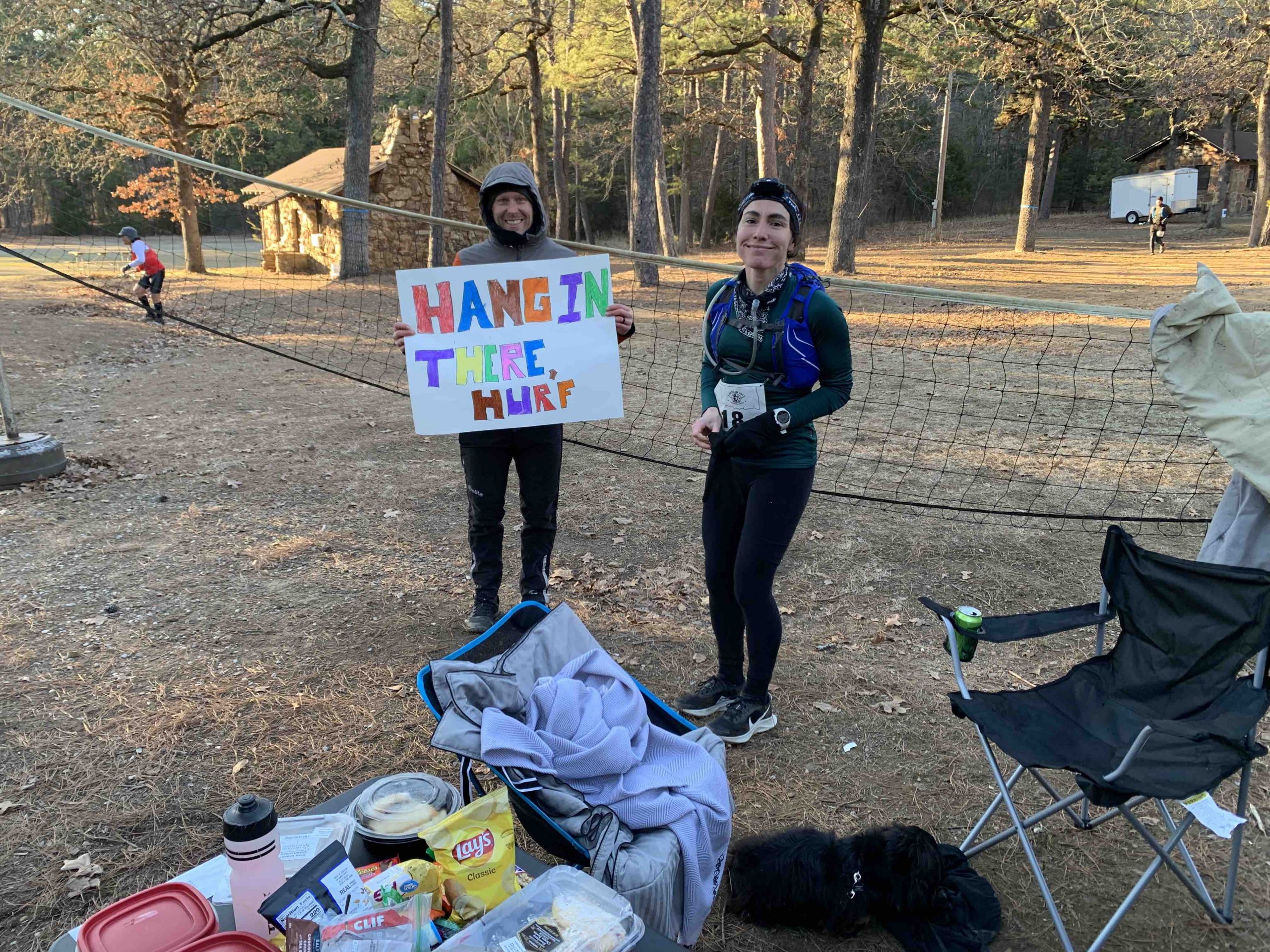I can now say that I’ve been on all sides of the ultra-running equation: I’ve been a crew member, I’ve been a pacer, and I’ve had a crew and a pacer. Back in September when I was part of the group that was crewing and pacing my friend Karen to her epic FKT of the Bruce Trail, I started thinking about the fact that being on the crew was very similar to my days managing a cyclocross team, and that helped dial my efforts in. But while there’s a ton out there about how to actually do the big miles and tackle major events as a racer, I feel like there’s not a lot of intel where the crew is concerned. Now, back in September, I thought I knew a lot about crewing because I had done it. Then, in February at Outlaw 100, I suddenly needed a pacer and crew, and got to see the equation play out on the other side.
Since more and more people are doing big races that include crews and pacers, or trying for FKTs, I thought it might be fun to do a ‘crew manual’ article packed with practical (and kind of funny) tips for crew so their job goes as smoothly as possible. This is running-based, but would also apply to crew for a cycling event like RAAM!
First… Understand crewing versus pacing
A lot of the time, the crew and pacer terms get tossed around like they’re the same thing, but they’re definitely not! Whether you’re running or supporting someone who’s running, know exactly what you’re signing up for. Crewing means that you’re in a van or bouncing between aid stations to provide support for your runner. Pacing means you’re actually running with them. If you sign up to crew, expect to be bored for long stretches, then super stressed for short bursts. If you’re pacing, make sure you are prepared to keep up with the runner, and prepared that the run—even if you’re about to do 50 miles overnight—isn’t about you and you damn well better be ready to take care of yourself. It’s not the runner’s problem if you can’t keep up or if you get a blister on your foot. You’re pacing, so you’re expected to keep it together. (Harsh—but as Karen said to me, in some ways, pacing is more stressful than racing because you worry you’ll have a bad day that will impact your runner!)
Know the rules of the race/event
Different events have different rules about where crews are allowed to provide aid, when a pacer can jump into the race, how many pacers a person can have, if the pacer is allowed to carry things (muling) or even literally connect to the other runner (towing) by a rope to provide some help. Make sure that you know the rules, because I can’t imagine how awful it would be to end up disqualified for not knowing that you couldn’t be at a certain aid station.
Put on your own oxygen mask first
As a crew member, I quickly realized that if I’m grumpy, I’m not helpful. As the runner, this actually popped into my head the few times I came through the aid station—my sense of guilt for making my husband and best friend stay up all night while I ran prompted me to keep checking in on if they were eating and sleeping… until mile 60, at which point I turned into a direction-barking diva. If my crew hadn’t been taking care of themselves, it could have been a whole lot worse, since the time when you need them to be at their best is the point when they’re at their most tired. (For crew: You’re almost certainly going to eat a lot of crap during this time, so consider adding things like a greens powder, multi-vitamin, and even protein shakes for yourself. And ensure that you’re as well-hydrated as your athlete!)
Know your athlete/know your crew
If possible, have him or her create flow charts or lists that dictate what they want (physically, mentally, emotionally) at stops. As the runner, I told my pacer that what I would need from her was a steady stream of chatter (which she is very, very good at) in addition to just having someone running next to me. When I was crewing/pacing for her, she had a similar list of preferences. (Tough love was higher on her list than it was on mine.) Do they need you to remind them to eat, or force-feed you at 2AM? Set the expectations ahead of time. Don’t know the crew / runner very well? It’s worth a few calls or video hangouts pre-race to just chat and get in sync.
Stick to the script
While you can offer foods and drinks that weren’t part of your athlete’s plan, definitely try to stick to their preferences and specifications as much as possible. A buffet of options is great, but don’t be offended when they don’t try that pizza you warmed up and just want their gel.
It gets GROSS.
It didn’t even occur to me that dropping into a chair, peeling off socks, and putting my foot in someone else’s lap to pop and tape my blisters was disgusting. It didn’t seem to occur to my crew, either, since they went right along with it. The same was true when I was crewing for Karen: Popping blisters, checking on chafe, and helping someone hobble to the bathroom and then back to bed during a multi-day effort involves coming in contact with a lot more bodily fluids than you would normally exchange with any human, ever.
Switch on and off if possible.
If you’re sharing crewing responsibilities, even if you both need to stay awake to help, try to switch who’s doing the lion’s share of the ‘thinking’ part while the other relaxes. This makes sense as the crew, but as the runner, it can be hard to follow along with at 3AM when you’re 80 miles into a 100. So while switching on and off is great, it needs to be done very carefully so as to not startle your runner.
Bank sleep ahead of time. You won’t be getting much.
This applies to both runners and their crew. Crew + pacing is EXHAUSTING. Be ready.
Have checklists for EVERYTHING.
This applies equally to runners and crew—the key is to ensure that the info is shared back and forth, rather than the crew doing all the thinking or the runner doing all the planning. Spreadsheets and Google Docs are your friend. So is a sheet of posterboard with everything listed out, from what you want to change into at dusk to what should get swapped out at each aid station to the 3 questions you want your crew to ask every time you come in. Watch the map and the forecast like a hawk in the days before, and have plans organized for every weather eventuality. The less questions crew members need to ask, the better. The less decisions a runner has to make, the better. (No one wants to — ahem — forget a heavier running coat and end up wearing a raincoat like a smock in order to try to keep a hydration bladder mouthpiece covered so that it thaws when temps drop at 2AM). And for crew, organize + clean constantly – a van, RV or car gets messy in minutes when you’re bopping from one aid station to the next!
Take advantage of bonus helpers.
If someone says they want to help, give them a specific task, like picking up pizza for everyone, or dropping off more of that anti-chafe cream. And if you really have nothing for them to do, suggest they take photos and videos, because you (the runner or crew) will have zero time for this.
Use judgement about emotional moments
This is a weird one, but important IMO. I remember the one time during Karen’s Bruce Trail FKT when she cried, and it was because friends showed up with a sign and one friend said the nicest thing to her and it just cued the waterworks. This wasn’t a bad thing, because she was having a good day and it was a nice moment. But there were definitely points where no emotion/tough love were the better choices, and to drop an emotional speech in would have been A Bad Idea. Similarly, during my race, Peter picked his moments to show up with emotional support—holding a poster that said Hang in There Hurf to commemorate the same poster that my mom made my dad for a triathlon the day before I was born at the midway point, but not at night when emotions were running high. And one point, when I was sitting down to change clothes and feeling a bit blah as the sun went down, he played a video our friend sent us of her son cheering me on. It made me cry, but in an entirely positive way. If you’re not sure how well an emotional moment will go over, err on the side of just being very unemotional (don’t be a dick, just don’t show pictures of cute puppies).
Don’t expect a thank you (right away)
If your runner doesn’t immediately thank you (not the case when we crewed for Karen, but I’m pretty sure I was relatively out of emotion and in a weird place when I finished and not as effusive in my thanks as I should have been), don’t be offended. They are absolutely shattered. And hopefully they’ll remember to do so later. And hopefully you’ll have a crew/pacer setup that flips like mine did, where a few months later, you can ask your runner to crew for you!
So that’s that: my best tips for crewing someone to ultra-running (or riding) success! Have any to add? Drop them in the comments!
Before you go, check out our book, Becoming A Consummate Athlete, right here:






